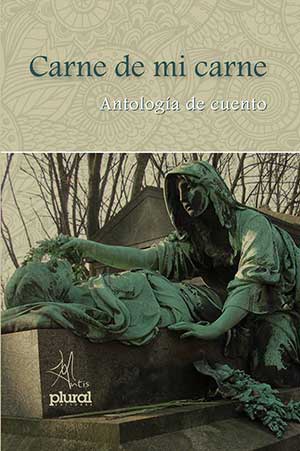Daughters of Prometheus: A Latin American Frankenstein
 Carne de mi carne: Antología de cuento (Plural Editores, 2018; Flesh of my flesh: Short-story anthology), is a collection of short stories inspired by the philosophical underpinnings of Mary Shelley’s Frankenstein, namely what it means to be a constructed, transhuman being/nonbeing (woman) and to live in the middle of an Industrial Revolution that generates both magic and misery. The anthology was the idea of writers and literary critics Giovanna Rivero and Magela Baudoin, who edited the volume. Maria Negroni wrote an intriguing introduction which set the stage for the other works of short fiction. Negroni and her fellow authors, all women writers from Latin America, contribute the body parts they will put together and then charge with divine afflatus and Indra’s vivifying lightning bolts (the imagination).
Carne de mi carne: Antología de cuento (Plural Editores, 2018; Flesh of my flesh: Short-story anthology), is a collection of short stories inspired by the philosophical underpinnings of Mary Shelley’s Frankenstein, namely what it means to be a constructed, transhuman being/nonbeing (woman) and to live in the middle of an Industrial Revolution that generates both magic and misery. The anthology was the idea of writers and literary critics Giovanna Rivero and Magela Baudoin, who edited the volume. Maria Negroni wrote an intriguing introduction which set the stage for the other works of short fiction. Negroni and her fellow authors, all women writers from Latin America, contribute the body parts they will put together and then charge with divine afflatus and Indra’s vivifying lightning bolts (the imagination).
Each author contributes a single fiction, which is themed and named after a body part. They are fascinating in their diversity and juxtaposition. Katya Adaui (Lima) contributes a hand in “No recuerdo haber incendido este cigarro” (I don’t remember having lit this cigar), which deals with the death of a paratrooper father whose war memories haunt him. Fernanda García Lao (Argentina) contributes the heart in “Huérfanos en la nieve” (Orphans in the Snow) which also has to do with death and awareness of the impending death of the father.
The brain is contributed by Rosario Barabona (Sucre, Bolivia). As one of the longest stories in the collection, it is also perhaps the most grounding. Entitled “Yo sé de tu delirio” (“I know about your delirium” or “I understand the mania”), it takes the form of a journal chronicling the activities of Jane Williams and her friend, Mary Shelley, just before Shelley’s death in 1851. Williams is a notable persona because Percy became obsessed with her and even wrote poems to her, most notably “To Jane: An Invitation,” which was an invitation for Jane to run off with him (apparently Mary was not very good company while suffering depression after the miscarriage of their child). The entries do not appear in chronological order but, instead, appear in ways that show the deep impact of love and loss. Mary has enshrined the tiny cradle and baby clothes of her lost child, while Jane has gone on to fall in love with a Mr. Howard and bear two children. It is a world of contradictions, of life, of the need to make sense of the world by means of a woman’s unique capacity to bear children, and the realities of paternal loss.
The diversity and variety of the tone, voice, and treatment of each part of the body invite the reader to consider each one as a separate story but, more than anything, to consider the kind of being that is created in the melding of all of them.
The other nine stories are equally intriguing. They are each quite unique and in no way uniform. The diversity and variety of the tone, voice, and treatment of each part of the body invite the reader to consider each one as a separate story but, more than anything, to consider the kind of being that is created in the melding of all of them.
Rivero and Baudoin's vision for the anthology, as laid out in Negroni's "Frankenstein, the Taste of Frozen Climates,” addresses the genre of the gothic and also the heroines who, like the body parts, are separate, “orphaned,” and live in a climate that is marked by darkness and cold. The energies that are evoked in the stories trigger a state of deep reflection about what it means to create (and to lose) life, to be a part of a whole, and to consider yourself comprised of fragments that can break apart at any time and reassemble disobediently; the creator’s intention being at best irrelevant and, at worst, monstrous.
University of Oklahoma















